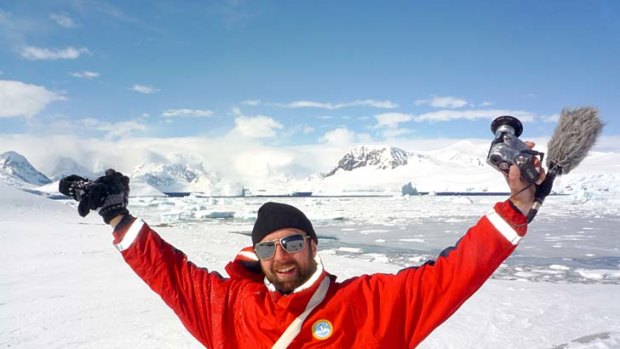
Michael Wigge made it to Antarctica at the end of a 40,000km trip that began in Berlin. Wigge made the journey for free by working his way and asking for favours.
Michael Wigge left Berlin without a penny and travelled 40,225km to Antarctica, hitchhiking, bartering and working his way by ship, plane, car and foot, from Europe to Canada and the US and then through Latin America.
A series about his project, How to Travel the World for Free, is airing on US television throughout May and June, using video Wigge shot of his adventures. Here are some details on how he did the project and how it went.
THE TRIP: Wigge, a travel journalist and videographer who speaks German, English and Spanish, left Berlin in June 2010 and travelled for 150 days through 11 countries, arriving in Antarctica in November 2010. More than 100 people helped, providing transportation, food and places to sleep. He planned the journey for a year before starting out, collecting contacts for those who might provide accommodations or odd jobs, but he also relied on the kindness of strangers.
FOOD: At first, Wigge scrounged for food from garbage bins behind supermarkets, but he soon realised that "Dumpster diving wasn't necessary. I could walk in and do a barter. I offered to clean the floor or the shelf or wash the dishes in the restaurant in exchange for an old sandwich. And most of the people I approached in shops, supermarkets and restaurants gave me something".
ACCOMMODATIONS AND ATTITUDES: In Latin America, he found that "people were very helpful if I went to their door and said, 'I have no idea where I will sleep tonight, can I sleep here?' There was this helpfulness, this hospitality, maybe because many people there are poor and they know how it feels. They didn't care about my story. But in the US, it was more about the story. They would say, 'This is cool, we want to help you reach your goal'. Americans really go for this".
WORK: He crossed the Atlantic working on a container ship from Belgium to Canada in exchange for his passage, doing everything from paint jobs to changing the oil in the engine room. In Las Vegas, he engaged in pillow fights for $1 on the street and offered his back as a "human sofa" for tired visitors. In San Francisco, he collected tips for "pushing heavy tourists up the hills". Eventually he had 300 $1 bills, which he used to buy a plane fare to Costa Rica. From there he hitchhiked to Panama, where he worked as a butler for the German ambassador.
To cross from Ushuaia, Argentina, to Antarctica, he worked on a luxury cruise ship as an assistant to the expedition leader. "You clean the boots of the tourists, you help them on the ice, you put red flags around the penguin field, you help refill the boats with gasoline," he said.
WORST JOB: Wigge's stint as a porter carrying tourists' luggage in exchange for a trip to Machu Picchu, the ancient Inca city in the Peruvian Andes, ended "in a bit of a mess. I was the worst porter the Andes had ever seen", he said.
The other workers were accustomed to handling tents and meals for tourists along the 80km, five-day route, then running ahead carrying 27kg luggage on their backs in time to set up the next campsite before the tourists arrived, all at 4267-metre elevations. But Wigge did not have the stamina to keep up.
"They said, 'This is not funny, you cannot do this, we do not want to lose our clients'," he recalled. "I apologised." After two days, they put his luggage on horses and allowed him to walk at a regular pace rather than staying behind and running ahead to help with campsites.
VIDEO DIARY: Wigge kept a "video diary" with the goal of eventually producing a TV series. To film himself and collect footage that was high-enough quality for TV, Wigge carried a Canon HDV 1080i camera with a good wide-angle lens and microphone. He ended up with dozens of tapes, which were edited down to five 30-minute segments.
He nearly lost the precious tapes while staying with a German expat in Cuzco, Peru. "The whole apartment burned down before we went to sleep," Wigge said. But he was able to get his travel bag - including the videos and camera - out, and looks back on the incident philosophically: "We are still alive."
RETURN TRIP: Once he'd achieved his goal of starting out with no money and completing a one-way trip to Antarctica, he had no qualms about accessing a bank account for a return fare to Germany.
ADVICE: "I would like to motivate people, inspire people," he said. "If you're not too vain to do something like pillow fighting or being a human sofa, you can barter your way from something very small to something very big. Why not travel and be a bit silly?"
For more inspiration, take a look at Wigge's website and self-published book, How to Travel the World for Free: I Did It, and You Can Do It, Too!
AP
Follow the Traveller section on Twitter @FairfaxTravel
Sign up for the Traveller newsletter
The latest travel news, tips and inspiration delivered to your inbox. Sign up now.